Always seagulls calling overhead
By Rebecca Jewell
See her work in WTP Vol. IV #3
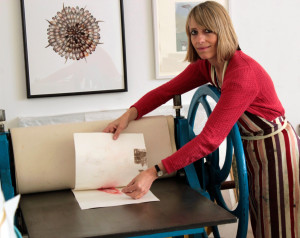
on her Hunter-Penrose Etching Press
[dropcap]I[/dropcap] work almost every day, printing in my studio at the Chocolate Factory in London. Although it is in the heart of Wood Green, there are always seagulls calling overhead. Dipping and diving, they remind me of Cornwall where I go on holiday. And magpies chatter outside, jumping from one window ledge to the other, wagging their tails up and down. Last year there was a sparrow hawk nesting in the disused building opposite.
I share my studio with two good friends, Lindsay, a painter and Lisa, a textile designer. We listen to Radio 4, drink tea, exchange ideas and ask each other for opinions about our work. When I am working towards a deadline, like for my recent show at the Rebecca Hossack Gallery, my studio is hard to move about in–every surface is spilling over with bags of feathers, tubes of inks, bottles of glue, antique glass domes, cabinets of eggs and printed feathers, bundles of willow sticks and rolls of netting. In recent years, my work has become increasingly mixed media.
I met the swan herd at Windsor and she gave me beautiful long white molted feathers from the rescued swans at the sanctuary.
Central to my printing work is my Hunter Penrose etching press, and of course feathers. I’ve always loved animals and nature – my parents were both zoologists, and when I was little we lived in Nigeria and had a pet chimp called Juma and a little zoo, where my mother reared orphaned baby animals. My parents took me on field trips, and bird watching, and every year my father would take me up a ladder to
look at the newly-hatched blue-tits inside the nest box in the garden.
A technique for printing images directly onto feathers
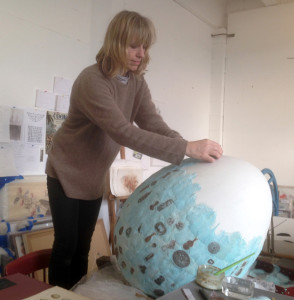
In the last few years I have made work about the illegal hunting and trapping of birds, and about the collecting of specimens and artifacts for museums. Using my press, I have perfected a technique for printing images directly onto feathers. I use either my own original drawings or photographs, or images from books—many hours are spent researching and looking for the right pictures to use. And then I have to find the right feather for the image—it has to curve in the right direction and be the correct width and shape. Sometimes it has to be steamed and “preened” first, so that the feather is smooth and neat.
I use molted feathers – from many different sources: my mother’s white doves and bantams, feathers from bird parks and zoos. And I met the swan herd at Windsor and she gave me beautiful long white molted feathers from the rescued swans at the sanctuary. I also buy white goose and turkey feathers from suppliers to the millinery trade.
Central to my printing work is my Hunter Penrose etching press, and of course feathers.
I use the paper-litho printing method: in several colors, I ink up a copy of the image with intaglio etching ink, and place it carefully on the bed of my press, with the feather on top. With some effort, I turn the huge wheel as quickly as I can, the printer making a grinding noise. I then throw back the blankets in order to peel off the printed feather.
I want each feather to tell its own story
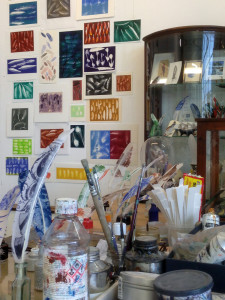
I must now have printed hundreds and hundreds of feathers, but every time I lift one off the plate, I still hold my breath in anticipation—the excitement never goes away. It is addictive. It worked! Do another one quickly. Quite often, half a day goes by with failures, but as the ink warms up and I get the colors just right and the pressure on the press perfect, towards the end of the day things start to go well. I am on a roll and can end up staying late.
I want each feather to tell its own story. Assembled and collaged together, either into headdresses, capes, onto enlarged photographs, or sewn onto hanging mist nets –the final artworks are a narrative of history, collecting, voyages and entrapment.ork
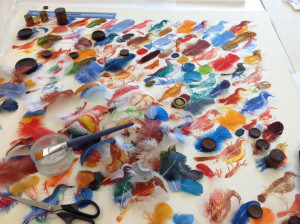

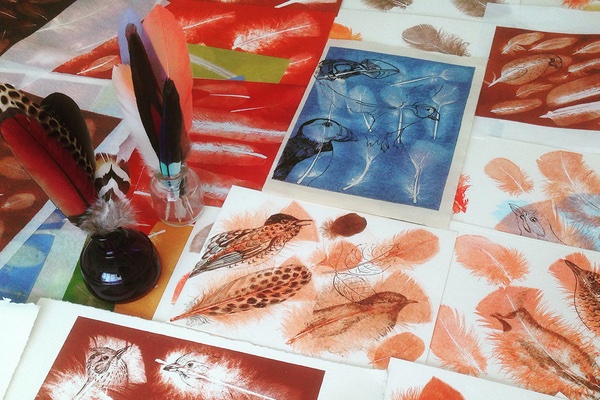
The texture and story of your work is compelling.